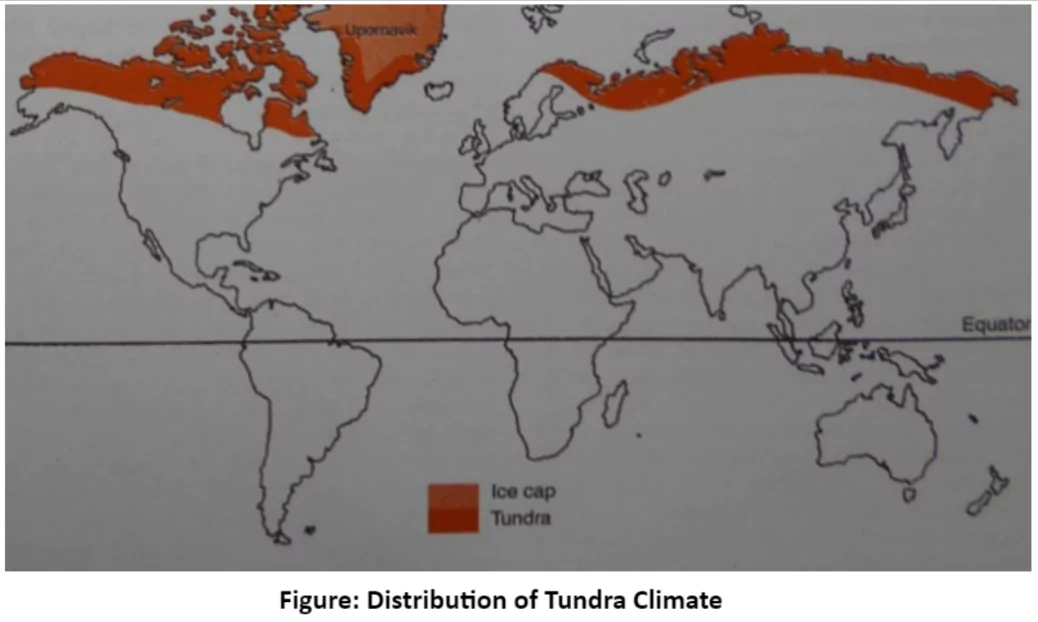Introduction
The tundra climate, found in Arctic and polar regions, features extreme cold and limited vegetation. Snow-covered landscapes and low temperatures define this harsh environment. Despite brief summers, plant growth is inhibited by frozen soil and weak sunlight. Human activities, mostly coastal, adapt to these challenging conditions, with traditional tribes like the Eskimos relying on hunting and fishing.
Overview of Arctic Tundra: Climate, Vegetation, and Economic Prospects
Distribution
- Northern Hemisphere: the polar climate and vegetation are mostly found above the Arctic Circle.
- Greenland and high-latitude areas have ice caps and snow-covered ground.
- Lowlands, like the coastal strip of Greenland, northern Canada, Alaska, and Eurasian Arctic seaboard, have tundra vegetation.
- Southern Hemisphere: Antarctica, Extremely cold with long winters, devoid of tall trees or forests, is mostly covered by ice caps, with thick layers of permanent ice reaching up to 10,000 feet.

Enroll now for UPSC Online Course
Climate
- Temperature: Extremely low mean annual temperatures, Winters harsh, often below -37°C;
- Summers: brief and cool with temperatures rarely exceeding 10°C. with weeks of continuous darkness within the Arctic and Antarctic Circles.
- Despite long periods of sunlight in summer, temperatures remain low due to weak sunlight, reflected by snow, and frozen soil inhibiting plant growth.
- Frost: Occurs year-round, and blizzards with speeds up to 130 mph pose risks for inhabitants.
- Coastal areas may experience thick fog, severely limiting visibility
- Precipitation: Generally low, with limited moisture in the form of snow and occasional freezing rain; Summer maximum precipitation in the form of rain or sleet.
- Precipitation is primarily snow, occurring in winter and drifting during blizzards.
- Snowfall varies, as do ice crystals or large flakes.
- Convectional rainfall is rare due to low evaporation rates and moisture in cold polar air.
- Tundra Regions: precipitation ranges from 25 to 35 cm annually but can exceed this in areas with frequent cyclones.
Vegetation
- There are no trees; Tundra vegetation is limited to hardy, low-growing plants, mosses, and lichens
- Permafrost: restricts the growth of deep-rooted plants;
- Drainage is poor in the tundra as the sub-soil remains frozen, leading to ponds, marshes, and waterlogged areas.
- Sheltered spots: stunted birches, dwarf willows, and small alders struggle to survive,
- Coastal Lowlands: support hardy grasses and reindeer moss;
- Brief Summer: Berry bushes and Arctic flowers bloom with the melting of snow, known as Arctic Prairies.
- Mammals: like wolves, foxes, musk-ox, Arctic hares, and lemmings thrive in the region.
Economic Activities

- Limited to Coastal Area: Human activities limited to the tundra are mostly near the coast.
- Few inhabitants lead a semi-nomadic life, adapting to the harsh conditions.
- Tribes: Eskimos in Greenland, northern Canada, and Alaska traditionally hunted, fished, and gathered food, but some now settle in permanent huts.
- Adaptation: to seasonal climate changes, living in igloos in winter and portable tents in summer, relying on fish, seals, walruses, and polar bears for food.
- European Contact: Eskimos’ way of life has evolved with European contacts,
- Modern houses and equipment in coastal areas, and
- Commercial Activities: like fur rearing and fishing.
- Eurasian tundra: Nomadic tribes like Lapps, Samoyeds, Yakuts, Koryaks, and Chuckchi, traditionally herd reindeer,
- Some are transitioning to settled life, with large farms established in Russia.
Recent Developments in the Arctic
- Economic Resurgence: The Arctic, once neglected, now holds economic importance due to mineral discoveries.
- Gold (Alaska), nickel (Russia), petroleum (Kenai Peninsula), and copper are mined in various Arctic regions, while coal extraction occurs in Spitsbergen and Alaska.
- New Settlements: Supported by government efforts to aid Arctic inhabitants and to exploit resources.
- Port Development: on the Eurasian Arctic seaboard facilitate timber and fur shipment from Siberia, aided by modern ice-breakers,
- Agricultural Experiments: Aim to extend the growing season and potentially utilize tundra for pastoral use.
- Potential for Colonization and Economic Growth: The Arctic’s healthy, pristine air is considered favourable for colonisation, reflecting it’s evolving importance and potential for economic development.
Enroll now for UPSC Online Classes
Conclusion
- The tundra climate presents unique challenges and opportunities. Its extreme cold and sparse vegetation shape both the environment and human activities. Traditional tribes like Eskimos maintain their way of life, while modern influences bring changes to coastal areas.
- As climate patterns evolve, understanding and adapting to the tundra environment remain crucial for both survival and sustainability.
- Recent developments in the Arctic, including economic resurgence through mineral discoveries and new settlements, highlight its evolving importance and potential for growth.
![]() May 1, 2024
May 1, 2024
![]() 1415
1415
![]() 0
0

